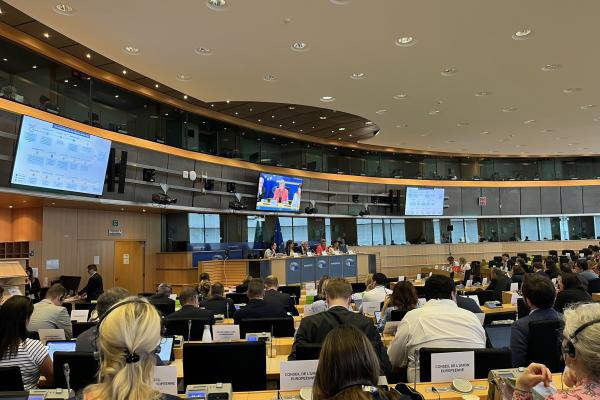What is the Pact on Migration and Asylum?
| The Pact on Migration and Asylum is a set of new rules managing migration and establishing a common asylum system at EU level, that deliver results while remaining grounded in our European values. They build on and amend previous reform proposals in the area of migration, offering a comprehensive approach that aims at strengthening and integrating key EU policies on migration, asylum, border management and integration. With firm but fair rules, they are designed to manage and normalise migration for the long term, providing EU countries with the flexibility to address the specific challenges they face, and necessary safeguards to protect people in need. Following their adoption by the European Parliament and Council, the new rules on migration introduced by the Pact entered into force on 11 June 2024 and will enter into application after two years. This will ensure that the Union has strong and secure external borders, that people's rights are guaranteed, and that no EU country is left alone under pressure. |

In this visual, four boxes representing different policy areas group the main components of the Pact on Migration and Asylum.
- Secure external borders: Robust screening, Eurodac asylum and migration database, Border procedure and returns, Crisis protocols and action against instrumentalisation.
- Fast and efficient procedures: Clear asylum rules, Guaranteeing people's rights, EU standards for refugee status qualification, Preventing abuses.
- Effective system of solidarity and responsibility: Permanent solidarity framework, Operational and financial support, Clearer rules on responsibility for asylum applications, Preventing secondary movements.
- Embedding migration in international partnerships: Preventing irregular departures, Fighting migrant smuggling, Cooperation on readmission, Promoting legal pathways.
The four pillars of the new migration and asylum policy
Secure external borders
| Robust screening: Those not fulfilling the conditions to enter the EU will be registered and subject to identification, security, and health checks. Eurodac asylum and migration database: The Eurodac Regulation turns the existing database into a fully-fledged asylum and migration database, ensuring clear identification of everyone who enters the EU as an asylum seeker or an irregular migrant. Border procedure and returns: A mandatory border procedure will apply for asylum applicants who are unlikely to need protection, mislead the authorities or present a security risk. Efficient returns with reintegration support will apply for those not eligible for international protection. Crisis protocols and action against instrumentalisation: The Crisis Regulation provides quick crisis protocols, with operational support and funding, in emergency situations. |
Factsheet - Secure external borders
Fast and efficient procedures
| Clear asylum rules: The Asylum Migration Management Regulation ensures effective determination of which EU country shall be responsible for handling an application for asylum. Guaranteeing people's rights: The Reception Conditions Directive establishes harmonised standards across the EU, ensuring adequate living conditions for asylum seekers, while strengthening safeguards and guarantees and improving integration processes. EU standards for refugee status qualifications: The Qualification Regulation strengthens and harmonises criteria for international protection and clarifies the rights and obligations of beneficiaries. Preventing abuses: The Asylum Procedure Regulation sets out clear obligations of cooperation for asylum seekers, providing for consequences in case of non-compliance. |
Factsheet - Fast and efficient procedures
Effective system of solidarity and responsibility
| Permanent solidarity framework: The new framework ensures that EU countries will receive the solidarity needed. EU countries choose how they will participate, between relocations, financial contributions, operational support, request deductions, and 'responsibility offsets'. Operational and financial support: Relevant EU Agencies and dedicated EU funds will support EU countries every step of the way. Clearer rules on responsibility for asylum applications: The new rules enhance the responsibility criteria determining the EU country responsible for assessing an asylum application. Preventing secondary movements: Asylum seekers must apply for international protection in the EU country of first entry and remain there until the country responsible for their application is determined. |
Factsheet - Effective system of solidarity and responsibility
Embedding migration in international partnerships
| Preventing irregular departures: Strengthened capacities of border management authorities in priority partner countries, including through reinforced cooperation with Frontex. Fighting migrant smuggling: Dedicated and tailor-made Anti-Smuggling Operational Partnerships with partner countries and UN agencies, tackling smuggling in key locations. Cooperation on readmission: The development of legal migration goes hand in hand with strengthened cooperation on return and readmission. Promoting legal pathways: An EU Talent Pool establishes the first EU-wide platform to facilitate international recruitment, while Talent Partnerships allow non-EU citizens to work, study, and train in the EU. |
Factsheet - Embedding migration in international partnerships
Timeline and main achievements

This visual displays the new Pact on Migration and Asylum's timeline and main achievements:
- September 2020: Proposals by the Commission on the New Pact on Migration and Asylum
- October 2021: Adoption of the Revised EU blue card Directive
- December 2021: Adoption EU Agency for Asylum
- March 2022: Appointment of an EU Return Coordinator
- April 2022: Proposals by the Commission on the Skills and Talent package
- June 2022: Launch of the Voluntary Solidarity Mechanism
- December 2022: Provisional agreement on the qualification Regulation
- December 2022: Provisional agreement on the Reception Conditions Directive
- December 2022: Provisional agreement on the Union Resettlement Framework Regulation
- December 2023: Provisional agreement on the Eurodac Regulation
- December 2023: Provisional agreement on the Screening Regulation
- December 2023: Provisional agreement on the Asylum Procedure Regulation
- December 2023: Provisional agreement on the Single Permit Directive
- December 2023: Provisional agreement on the Asylum and Migration Management Regulation
- December 2023: Provisional agreement on the CrisisRegulation
- December 2023: Political agreement
- April 2024: European Parliament vote
- May 2024: Adoption by the Council of the EU





